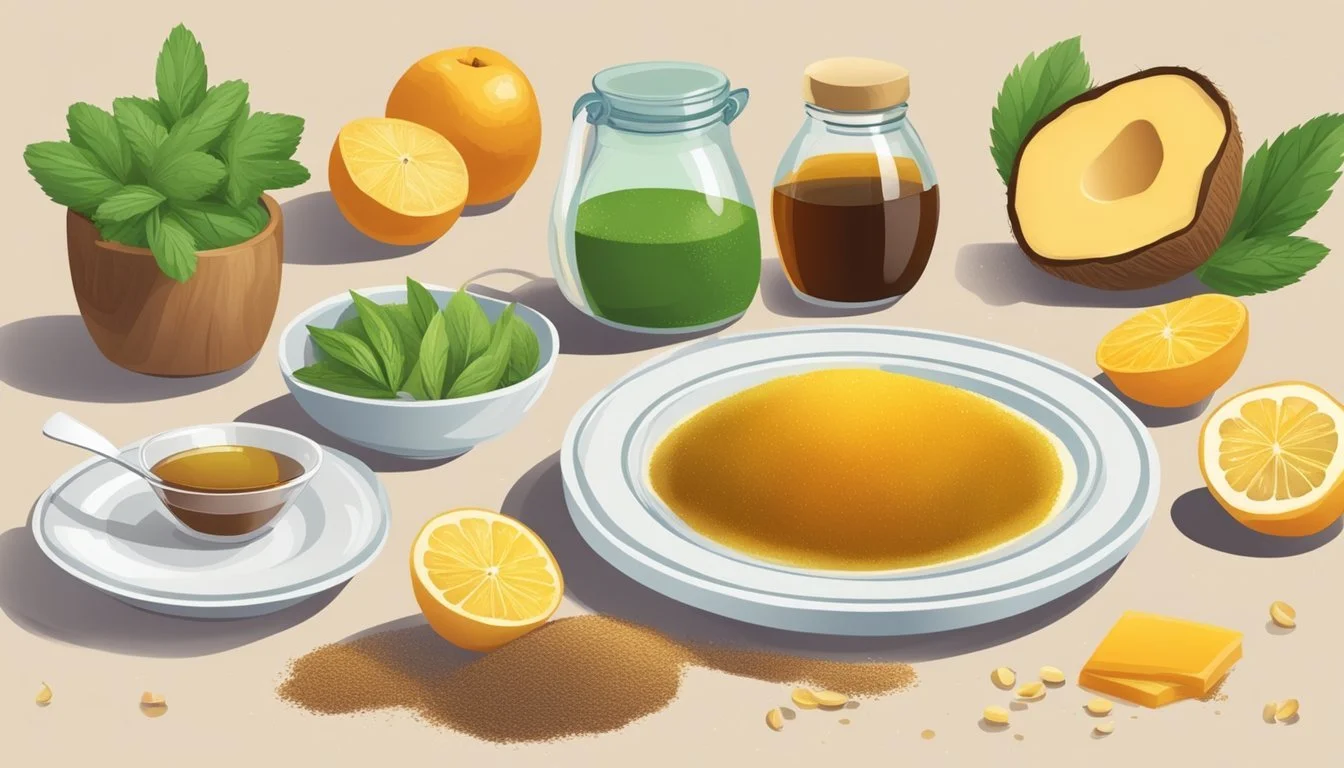Paleo Diet and Natural Sweeteners
Paleo Diet and Natural Sweeteners: Unveiling Healthy Sugar Alternatives
The Paleo diet, often referred to as the 'caveman diet,' promotes the consumption of whole, unprocessed foods similar to those our Paleolithic ancestors purportedly ate. It emphasizes meats, seafood, vegetables, fruits, and nuts while excluding grains, legumes, processed foods, and refined sugars. The rationale behind the Paleo diet is to eat foods that are more aligned with human genetics, which proponents argue can lead to better health and fewer chronic diseases.
When it comes to sweetening foods or beverages, the Paleo diet presents unique challenges due to its restrictions on refined sugars. Natural sweeteners come into play as alternatives, provided they align with the diet's principles. Options like maple syrup and honey are considered acceptable by many following the diet because they are unrefined and contain trace amounts of vitamins and minerals. However, it's important to choose darker, less processed versions of these sweeteners, such as grade B maple syrup, to stay closer to Paleo guidelines.
Discernment is key when selecting Paleo-friendly sweeteners, as the market is replete with products claiming to be natural. Sweeteners derived from grains, like brown rice syrup, are not Paleo-compliant due to the diet's exclusion of grains. The focus remains on sweeteners that undergo minimal processing and closely resemble their original form in nature. By doing so, individuals on the Paleo diet can enjoy a touch of sweetness while adhering to the diet's overarching philosophy of eating as naturally as possible.
Understanding the Paleo Diet
The Paleo Diet is fashioned after the dietary habits of ancient hunter-gatherer societies, emphasizing whole, nutrient-rich foods.
Principles of Paleo
The Paleo Diet is rooted in the concept that humans should eat more like their Paleolithic ancestors — which means focusing on foods that could be hunted or gathered. It operates on the idea that the advent of farming and processing foods has contributed to modern-day health issues, from obesity to allergies.
Key Features of the Paleo Diet:
Focus on Whole Foods: Nutrient-dense foods that are minimally processed.
High Protein Intake: Meat constitutes a significant part of the diet.
Low Carb and Low Glycemic Load: Reliance on fruits and vegetables for carbohydrates.
Foods to Include
Proponents of the Paleo Diet recommend a variety of whole foods:
Meats: Preferably grass-fed, organic, or free-range options.
Fish and Seafood: Wild-caught is ideal.
Fresh Vegetables: Emphasized as a staple.
Fruits: Eaten in moderation due to natural sugar content.
Nuts and Seeds: Varied consumption for adequate protein and fat intake.
Note: Some Paleo followers opt for organic produce to minimize exposure to pesticides.
Foods to Avoid
Certain food groups are excluded from the Paleo Diet:
Grains: All grains, including wheat, rice, and corn, are excluded.
Legumes: Beans, lentils, and peanuts are off-limits.
Dairy Products: Milk, cheese, and yogurt are to be avoided.
Processed Foods and Sugars: Products with added sugars and heavily processed foods are strictly prohibited.
Summary Table:
Include Avoid
Grass-fed meat Grains
Organic vegetables Dairy
Nuts and seeds Legumes
Wild-caught fish and seafood Processed foods and sugars
Fruits (in moderation)
By strictly adhering to these dietary guidelines, the Paleo Diet aims to emulate a way of eating that is closer to that of early humans, before agriculture and industrialization.
The Role of Sweeteners in the Paleo Diet
The Paleo diet places an emphasis on whole, unprocessed foods and natural sweeteners, while avoiding refined sugars and artificial additives. Understanding the types and roles of sweeteners permissible within this dietary framework is essential for adherents to maintain their nutritional goals.
Paleo Sweeteners Overview
Paleo sweeteners are derived from natural sources and do not undergo extensive processing. They maintain a closer resemblance to how these sugars are found in nature, which aligns with the Paleo principle of consuming foods in their most original form. Honey, maple syrup, and coconut sugar are common examples of Paleo-approved sweeteners. They offer a sweet taste to recipes and can be used in moderation, accepting that the Paleo diet primarily focuses on foods with lower glycemic indexes to avoid spikes in blood sugar levels.
Natural Vs. Artificial Sweeteners
Natural sweeteners on the Paleo diet include those that are unrefined and minimally processed. They should come from natural sources and be free from artificial additives. In contrast, artificial sweeteners, although often low in calories, are created through chemical processes and are not considered Paleo-friendly. This category also includes sugar alcohols, which may cause digestive issues and are artificially produced, making them unsuitable for those adhering to Paleo dietary principles.
Evaluating Sweeteners on Paleo
When evaluating sweeteners for a Paleo diet, it is important to examine their source and processing level. A sweetener's impact on blood sugar levels is another critical factor, with a preference for those having minimal effect. For instance:
Raw honey is preferable to refined because it is less processed.
Maple syrup should be 100% pure and preferably dark (grade B) for its robust flavor and nutrients.
Coconut sugar is favored over white sugar due to its natural origins and the presence of some nutrients.
Sweeteners like high fructose corn syrup, as well as the array of other highly processed sugars, are incompatible with the Paleo diet due to their refined nature and the adverse health effects associated with their consumption.
Natural Sweeteners and Their Nutritional Profiles
When considering natural sweeteners on a Paleo diet, one must evaluate their nutritional content, including calories, minerals, and sugar composition, to make informed choices. Here's a breakdown of several natural sweeteners and what they bring to the table nutritionally.
Honey and Its Benefits
Honey is a natural sweetener rich in antioxidants and may provide trace amounts of vitamins and minerals. It primarily contains fructose and glucose. Raw honey offers greater benefits with higher levels of bioactive plant compounds and antioxidants.
Maple Syrup Nutrition
Maple syrup is a source of minerals such as calcium, potassium, iron, and zinc. It's mainly composed of sucrose with smaller amounts of fructose and glucose. Darker grade syrups, like Grade B, are less refined and retain more nutrients.
Coconut Sugar Characteristics
Coconut sugar, with a lower glycemic index than regular sugar, boasts a modest amount of nutrients such as iron and zinc. It also contains inulin, a type of dietary fiber that may help with blood sugar management.
Stevia and Its Uses
Stevia is a calorie-free sweetener derived from the leaves of the Stevia rebaudiana plant. It’s known for its high-intensity sweetness, and it does not raise blood glucose levels, making it a suitable option for those monitoring their sugar intake.
Monk Fruit Sweetness
Monk fruit sweetener, also known as Luo Han Guo, gets its sweetness from mogrosides rather than fructose or glucose. It contains no calories and has no impact on blood sugar levels. Monk fruit extracts can be up to 200 times sweeter than sugar.
Dates as Sweeteners
Dates are a whole-food sweetener, providing nutrients like potassium, magnesium, and fiber. They contain a high amount of natural sugars, mainly fructose and glucose, and have a caramel-like sweetness.
Molasses Composition
Molasses is a byproduct of the sugar-making process with a robust flavor. It’s a good source of vitamins and minerals, such as iron, calcium, potassium, and vitamin B6. Darker molasses varieties tend to have a higher mineral content.
Health Implications of Sweeteners
The consumption of sweeteners, both natural and synthetic, significantly impacts health. Specific sweeteners influence blood sugar levels, body weight, heart health, and can either mitigate or exacerbate the risks of diabetes. It's crucial to understand these varied effects when incorporating sweeteners into a Paleo diet.
Blood Sugar and Insulin Response
Natural sweeteners such as honey and maple syrup contain fructose and glucose. While these may be Paleo-compliant, they still provoke an insulin response, which can affect blood sugar levels. However, options like stevia do not elicit the same response, potentially aiding in blood sugar control.
Weight Management and Obesity
One's choice of sweetener can have a direct impact on weight management. For instance, artificial sweeteners lacking calories are sometimes used to reduce overall calorie intake. Yet, natural sweeteners high in calories can contribute to weight gain if not consumed in moderation.
Preventing Heart Disease
Sweeteners high in fructose, such as high-fructose corn syrup, have been linked to an increased risk of heart disease. In contrast, natural sweeteners may not significantly impact heart disease risk if used in moderation and as part of a balanced diet. However, it is essential to limit sweetener intake to maintain heart health.
Diabetes Considerations
For individuals managing diabetes, understanding the glycemic index of sweeteners is paramount. Some natural sweeteners may result in a slower release of glucose into the bloodstream, which can be beneficial. Yet, high consumption of any sweetener could still pose a challenge for blood sugar regulation in diabetics.
Incorporating Sweeteners into a Paleo Diet
When adopting a Paleo lifestyle, an individual may still enjoy sweet flavors while adhering to the dietary principles. Choosing natural sweeteners and incorporating them appropriately ensures this balance.
Creating a Balanced Meal Plan
Individuals can incorporate natural sweeteners into their Paleo meal plan by ensuring these sweeteners complement the overall nutritional value. For breakfast, one might add a drizzle of grade B maple syrup to almond flour pancakes, providing a sweet taste without overwhelming the meal with sugars. Lunch could consist of a salad dressed with a honey-mustard vinaigrette, adding a touch of sweetness. Dinner may include a glaze made from reduced fruit juice over baked salmon, allowing for a subtle, natural sweetness.
Sweeteners in Paleo Recipes
In Paleo recipes, natural sweeteners replace refined sugars to enhance the flavor of dishes without artificial ingredients. Raw honey can be used in baking for a slightly floral note, while pure maple syrup may serve as a sweetener in marinades and dressings. When creating Paleo desserts, coconut sugar provides a lower glycemic index alternative, fitting in seamlessly with the diet's unprocessed ethos.
When to Use Sweeteners Sparingly
While natural sweeteners are permissible within a Paleo diet, moderation is key. They should be used sparingly to avoid excessive sugar consumption. For instance, it's advisable to sweeten a homemade Paleo treat with a modest amount of dates or banana puree rather than large quantities of honey or syrup. Limiting the use of sweeteners helps maintain the dietary balance central to a Paleo lifestyle.
Choosing Sweeteners: Practical Tips
When adhering to a Paleo diet, selecting the right sweeteners can enhance the flavors of foods and beverages like coffee and tea while staying true to the diet's principles. Here are ways to navigate sweetener choices and incorporate them effectively in your diet.
Sweetener Selection for Your Pantry
In building a Paleo-friendly pantry, one should focus on unprocessed and organic sweeteners. Honey and maple syrup are two staples, with raw honey being a preferred option due to its less processed nature. Maple syrup should be Grade B (now known as Grade A Dark Color, Robust Taste) to ensure it has undergone minimal processing.
List of Paleo Sweeteners for Pantry:
Raw honey
Organic maple syrup (Grade A Dark Color, Robust Taste)
Stevia (with no additives)
Shopping for Natural Sweeteners
While shopping, it is crucial to read labels to avoid sweeteners with additives like high fructose corn syrup. Look for words such as "pure" or "100%" which can suggest the product is less refined. Organic labels also indicate a lack of pesticides which aligns with Paleo values.
Tips for Shopping:
Read ingredient labels carefully.
Choose products labeled as "organic" or "100% pure".
Avoid anything that lists additives or artificial flavorings.
Cooking with Sweeteners Advice
Using sweeteners in cooking requires understanding their unique properties. For example, honey can add moisture to baked goods, while maple syrup may introduce a distinct flavor. Substituting sugar in recipes with Paleo sweeteners often isn't a 1:1 ratio; adjustments should be anticipated based on the sweetener's texture and sweetness level.
Cooking Considerations:
Honey: Adds moisture; may need to reduce other liquids in the recipe.
Maple Syrup: Imparts rich flavor; use less than you would white sugar due to high sweetness.
Stevia: Much sweeter than sugar; start with small amounts and adjust to taste.
Addressing Common Concerns and Myths
This section is designed to tackle prevalent misconceptions and address the frequent concerns surrounding natural sweeteners and the Paleo diet, assuring readers have the correct information to make informed decisions.
Sugar Addiction and Withdrawal
Sugar addiction is often mentioned concerning dietary changes. The concern is that eliminating sugar abruptly can lead to withdrawal symptoms. While withdrawal can occur, resembling symptoms of addiction to other substances, a registered dietitian can provide strategies for gradually reducing sugar intake, thereby mitigating potential withdrawal effects. The Paleo diet emphasizes the elimination of added sugar, not the sugars found naturally in whole foods.
Paleo Diet Misconceptions
Misconceptions regarding the Paleo diet often revolve around the idea of consuming certain types of foods strictly from the Paleolithic era. However, the diet's primary goal is eating unprocessed, whole foods. It does not require strictly historical food sources but rather suggests choosing grass-fed and pastured options when possible. The objective is to avoid processed foods and added sugars, not to replicate an ancient diet in an exact manner.
Sweeteners and Paleo Purity
The Paleo community debates the pros and cons of including natural sweeteners in a Paleo diet. The emphasis is on "Paleo purity", a concept which often pertains to abstaining from any sweeteners. Nonetheless, natural sweeteners like honey and maple syrup can have a place within the Paleo framework, provided they are used sparingly. It is important to note that added flavorings or high fructose corn syrup adulterate these natural sweeteners, and thus, should be avoided.
Conclusion
The Paleo diet encourages the use of natural sweeteners as a means to adhere to the dietary patterns of our Paleolithic ancestors. These sweeteners include:
Maple syrup: Preferrably darker, amber versions like "grade B" which are less refined.
Honey: A natural sweetener that also provides antioxidants.
Stevia: A plant-based sweetener with no calories.
Individuals should select sweeteners that are minimally processed to stay in line with the Paleo principles. It's important to note that moderation is key, as even natural sweeteners can contribute to excessive sugar intake.
When choosing a sweetener, one must be vigilant about ingredient labels to avoid added chemicals or high fructose corn syrup, which are not in compliance with the Paleo guidelines. The adoption of these natural sweetening agents should be done with the understanding that the core of the Paleo diet focuses on whole, unprocessed foods.
Transforming one's diet to reflect the Paleolithic era does not necessitate the exclusion of all sweet tastes; instead, it calls for a thoughtful selection and consumption of sweeteners that align with Paleo's fundamental concept.







